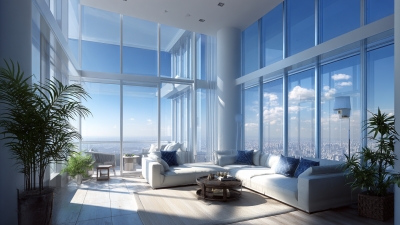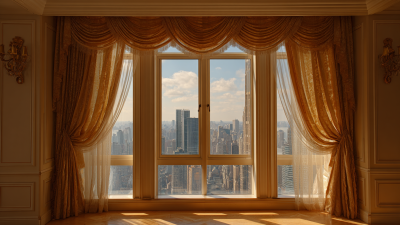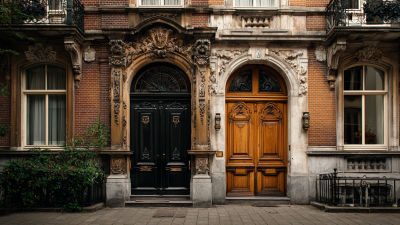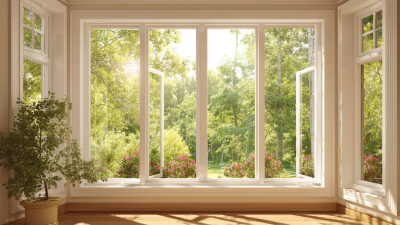Innovative Examples of Interior Doors Transforming Modern Spaces with Industry Insights
As modern spaces continue to evolve, the role of interior doors has transcended mere functionality to become pivotal elements in interior design. According to a recent report by the Interior Design Association, the global market for interior doors is projected to reach $35 billion by 2027, driven by a growing demand for customized design solutions and sustainable materials. Interior doors are no longer just barriers between rooms; they are transformative features that enhance aesthetics, improve acoustics, and optimize space utilization.

With innovations ranging from sliding barn doors to minimalist frameless options, today's interior doors reflect a blend of style and technology, catering to diverse consumer preferences. This blog will explore innovative examples of how interior doors are reshaping modern spaces, providing industry insights into the latest trends and design strategies.
Table of Contents
[Hide]
Creative Uses of Bi-Fold Doors to Maximize Space in Small Areas
Bi-fold doors have emerged as a game-changing solution for maximizing space in small areas, seamlessly blending functionality with aesthetic appeal. According to a report by the National Association of Home Builders (NAHB), bi-fold doors can increase the perceived square footage of a room by creating an open flow between indoor and outdoor spaces. This architectural innovation not only enhances the functionality of small rooms but also allows for natural light to flood in, making spaces feel larger and more inviting.
In urban living situations, where every square foot counts, bi-fold doors are becoming increasingly popular. A study by Grand View Research highlights that the global bi-fold door market is expected to reach $1.2 billion by 2025, with a significant rise in demand for space-saving solutions. These doors enable homeowners to create flexible environments, transforming living areas into dining spaces or home offices with ease. This versatility is particularly beneficial in smaller homes, where maximizing utility without compromising style is essential. With their sleek design and practicality, bi-fold doors are revolutionizing the way we think about space in modern interiors.
The Rise of Smart Doors: Integrating Technology into Interior Designs
As the intersection of technology and design continues to evolve, the rise of smart doors is revolutionizing the way we think about interior spaces. Modern smart doors are equipped with integrated circuits and sensors, allowing for features like keyless entry, remote unlocking, and even automated security alerts. According to the latest industry reports, the demand for smart technology in residential and commercial interiors has surged, reflecting a growing consumer preference for convenience and enhanced security. The integration of advanced chips plays a critical role in this shift, as these components ensure the seamless operation of smart features.
Moreover, with the increasing adoption of IoT (Internet of Things) applications, smart doors are becoming integral to smart home ecosystems. A recent study highlights that the global market for smart home devices, which includes smart doors, is projected to reach significant revenue milestones by the end of the decade. This growth indicates a broad shift in consumer behavior, signaling that the integration of technology into interior design is not just a fleeting trend but a lasting evolution in how we interact with our living environments. As architects and designers embrace these technological advancements, smart doors will emerge as pivotal elements in crafting innovative and secure modern spaces.
Innovative Examples of Interior Doors: Smart Door Technology Adoption
This chart illustrates the increasing adoption of smart door technology in modern interior design from 2018 to 2023. It highlights the percentage of homes utilizing smart doors, reflecting a growing trend towards integrating technology into daily living environments.
Sustainable Materials in Door Manufacturing: An Eco-Friendly Approach
In recent years, the shift towards sustainability in design has led to a remarkable transformation in door manufacturing. Manufacturers are increasingly opting for eco-friendly materials that reduce environmental impact while maintaining durability and aesthetic appeal.
For instance, bamboo and reclaimed wood have emerged as popular choices. Bamboo, known for its rapid growth and renewability, offers a strong yet lightweight option that requires minimal resources to cultivate. Reclaimed wood not only contributes to the circular economy but also imparts a unique character to each door, with the history of the material adding depth to modern spaces.
Additionally, advancements in sustainable practices have prompted the use of non-toxic finishes and adhesives, minimizing harmful emissions in interior environments. Manufacturers are exploring innovative materials such as recycled metal and biocomposite materials, which blend natural fibers with biodegradable plastics.
These developments not only promote eco-consciousness but also expand design possibilities, allowing for modern styles that align with today’s aesthetic preferences. As consumers become increasingly aware of their environmental footprint, the integration of sustainable materials in door manufacturing is not just a trend but a vital component of creating harmonious and responsible living spaces.
Statement-Making Pocket Doors: A Seamless Blend of Function and Style
Pocket doors are increasingly recognized as a compelling design choice for modern interiors, merging functionality with aesthetic appeal. According to a report by the American Institute of Architects (AIA), the demand for pocket doors has surged by 15% over the past three years as homeowners seek innovative solutions for space optimization. These doors slide into the wall, freeing up floor space. This feature is particularly beneficial in urban environments where square footage is limited, allowing for a more open, airy feel in compact living spaces.
In addition to their space-saving benefits, pocket doors also serve as versatile design elements that can enhance the overall look of a room. According to a study by the National Association of Home Builders (NAHB), homes featuring statement-making pocket doors not only improve functionality but also add a chic stylistic flair that appeals to potential buyers. With a variety of materials and finishes available, from frosted glass to solid wood, pocket doors can be tailored to fit any design theme, making them an excellent choice for those looking to elevate their modern interiors. As the industry continues to embrace innovation, these doors are likely to become a staple in contemporary home design.

Artistic Glass Doors: Enhancing Light and Aesthetics in Modern Interiors
Artistic glass doors have become a game-changing element in modern interior design, offering a seamless blend of functionality and aesthetic appeal. These doors not only allow natural light to flood into spaces, but they also serve as stunning decor pieces that enhance the overall ambiance. From frosted patterns to intricate designs, artistic glass doors can transform ordinary rooms into visually captivating environments, making them a popular choice for homeowners and designers alike.
The versatility of artistic glass doors makes them suitable for various applications, whether it's in a home office, living room, or even commercial spaces. Their ability to create an illusion of more space while providing privacy is unmatched. Additionally, advancements in glass technology have led to options that prioritize energy efficiency and safety, ensuring that these doors are not only beautiful but also practical. By integrating artistic glass doors into modern interiors, designers can elevate the aesthetic while optimizing the flow of light and enhancing the experience of any space.

Related Posts
-

Exploring Unique Alternatives to Traditional Big Windows for Modern Spaces
-

Top Strategies for Sourcing Stylish Windows in a Competitive Global Market
-

Innovative Designs for Doors and Windows That Transform Spaces Globally
-

What are the Benefits of Choosing Energy Efficient Windows for Your Home
-

Ultimate Guide to Choosing the Perfect House Windows for Your Home
-

7 Secrets to Choosing the Best Energy Efficient Windows for Your Home